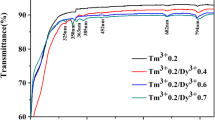Organo-inorganic hybrid materials based on inorganic oxyfluoride lead-borosilicate glass matrices and the metal-complex compound tris-(8-oxycholate) ytterbium (III) were obtained by the melt method. The spectral-luminescence properties of tris-(8-oxycholate) ytterbium and hybrid materials in the visible and IR ranges were studied under different excitations (377 and 785 nm). It is shown that the intensity of IR luminescence in the initial metal-complex luminophore surpasses the luminescence in the visible range and vice versa in the obtained hybrid materials — the intensity of visible luminescence significantly surpasses the IR-luminescence.





Similar content being viewed by others
References
U. Schubert, “Cluster-based inorganic-organic hybrid materials,” Chem. Soc. Rev., 40, 575 – 582 (2011).
B. Lebeau and P. Innocenzi, “Hybrid materials for optics and photonics,” Chem. Soc. Rev., 40, 886 – 906 (2011).
S. Parola, B. Julián-López, L. D. Carlos, and C. Carlos, “Optical properties of hybrid organic-inorganic materials and their applications,” Adv. Funct. Mater., 26, 6506 – 6544 (2016).
W. Liu, W. P. Lustig, and J. Lib, “Luminescent inorganic-organic hybrid semiconductor materials for energy-saving lighting applications,” Energy Chem., 1(2), 100008 (2019).
B. Escribano, B. Julián-López, J. Planelles-Aragó, E. Cordoncillo, et al., “Photonic and nanobiophotonic properties of luminescent lanthanide-doped hybrid organic-inorganic materials,” J. Mater. Chem., 18, 23 – 40 (2008).
E. Cordoncillo, P. Escribano, F. J. Guaita, et al., “Optical properties of lanthanide doped hybrid organicinorganic materials,” J. Sol-Gel Sci. Technol., 24, 155 – 165 (2002).
W. Que and X. Hu, “Optical switch and luminescence properties of sol-gel hybrid organic-inorganic materials containing azobenzene groups and doped with neodymium ions,” Appl. Phys. B, 88, 557 – 561 (2007).
K. I. Runina, M. N. Mayakova, I. V. Taydakov, et al., “Luminescent hybrid materials based on metal-organic phosphors in PbF2 powder and PbF2 -containing glass matrix,” Opt. Mater., 88, 378 – 384 (2019).
O. Petrova, I. Taydakov, M. Anurova, et al., “New fluorescent hybrid materials based on Eu-complexes in oxyfluoride glass and glass-ceramic matrix,” Periodica Polytech.: Chem. Eng., 60(3), 152 – 156 (2016).
I. V. Taidakov, A. N. Lobanov, L. S. Lepnev, and A. G. Vitukhnovskii, “Neodymium(III) tris(1,3-bis(1,3-dimethyl-1Hpyrazol-4-yl)propane-1,3- dionato)(1,10-phenanthroline): Synthesis and photophysical properties,” Russ. J. Coord. Chem., 40(1), 16 – 22 (2014) [Koord. Khim., 40(1), 20 – 26 (2014)].
D. A. Metlina, M. T. Metlin, S. A. Ambrozevich, et al., “Bright NIR-luminescent Nd3+ complexes with pyrazolesubstituted 1,3-diketones demonstrated unusual spectral lines branching ratios,” Dyes and Pigments, 181, 108558 (2020).
M. O. Anurova, K. I. Runina, A. V. Khomyakov, et al., “The effect of borate glass matrix on the luminescence properties of organic–inorganic hybrid materials,” Phys. Chem. Glasses: Europ. J. Glass Sci. Technol., Pt B, 60(4), 140 – 145 (2019).
Q. Zhang, X. Yang, R. Deng, et al., “Synthesis and near infrared luminescence properties of a series of lanthanide complexes with POSS modified ligands,” Molecules, 24(7), 1253 (2019).
L. R. P. Kassab, L. C. Courrol, N. U.Wetter, et al., “Lead fluoroborate glass doped with ytterbium,” J. Alloys Compd., 344, 264 – 267 (2002).
E. Najafi, M. M. Amini, E. Mohajerani, et al., “Fabrication of an organic light-emitting diode (OLED) from a two-dimensional lead (II) coordination polymer,” Inorg. Chim. Acta, 399, 119 – 125 (2013).
Q. Mei, N. Du, and M. Lu, “Synthesis and characterization of high molecular weight metaloquinolate-containing polymers,” J. Appl. Polymer Sci., 99, 1945 – 1952 (2006).
D. V. Bharathi, P. Arulmozhichelvan, and P. Murugakoothan, “Synthesis and characterization of Znq2 and Znq2 : CTAB particles for optical applications,” Bull. Mater. Sci., 40, 1049 – 1053 (2017).
Acknowledgement
This work was funded under grant 19-79-10003 by the Russian Science Foundation.
Author information
Authors and Affiliations
Corresponding author
Additional information
Translated from Steklo i Keramika, No. 6, pp. 3 – 7, June, 2021.
Rights and permissions
About this article
Cite this article
Runina, K.I., Popkova, L.V., Khomyakov, A.V. et al. Infrared Luminescent Hybrid Materials Based on Inorganic Glass Matrices. Glass Ceram 78, 215–218 (2021). https://doi.org/10.1007/s10717-021-00382-0
Published:
Issue Date:
DOI: https://doi.org/10.1007/s10717-021-00382-0




